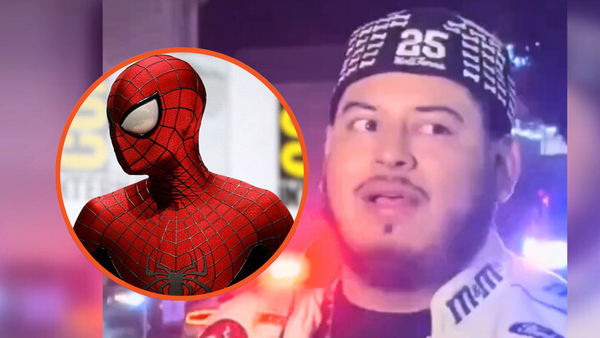
Actors Jameela Jamil, D’Arcy Carden, Manny Jacinto, and William Jackson Harper are sitting in a row, their heads tilted forward in anticipation. The viral video in which they are captured is called Cast of The Good Place React to Season 1 Finale, and it has 870,000 views.
About 28 seconds into the video, Jamil and Carden bring their hands to their mouths in shock, Harper lets out an appreciative “OHHH!” and Jacinto shakes his head in disbelief. The show’s stars have just been told that their characters have not been in heaven – as series creator Michael Schur led them to believe while filming The Good Place’s first 12 episodes – but they have been in hell, “The Bad Place”, all along.
The audience reacted with similar shock and glee; the reveal is ranked sixth on the Ringer’s list of the 50 best movie and TV twists of all time. The twist is a precisely measured mix of simple and unpredictable: the audience thought four problematic people had mistakenly been sent to heaven and were trying their hardest to fit in and learn how to be good. High jinks and horrors ensued until our protagonist Eleanor Shellstrop (Kristen Bell) figured out there had been no mistake: this was an elaborate form of psychological torture designed by a demon called Michael (Ted Danson).
From the Red Wedding in Game of Thrones to Breaking Bad’s extremely shocking zoom-in on a plant pot, we all know how amazing it feels to watch a killer twist: the goosepimples on our arms, the uncontrollable “OHHH!”.
This year, another show has continued that long tradition. Apple TV+’s Severance, which aired in spring, was a delicious buffet of “Someone-we-believed-was-dead-isn’t-dead”, and, “Oh-no-this-character is-the-exact-opposite-of-what-we-thought” reveals. But while the TV twist may seem like an act of sorcery, there is an art to writing one. How do you master sucker punches like Severance’s many surprises or The Good Place’s big reveal? And how do you keep them secret from cast and crew?
“It was bizarre, because I was like: ‘This is a show that’s essentially about ethics, and I’m now going to lie to my co-workers for months,’” says Schur of The Good Place. To avoid leaks and to stop the actors overthinking their roles, he kept the twist on a need-to-know basis: of the six main cast, only Bell and Danson knew. “I later found out that Ted was blabbing it all over town,” he says, “but fortunately, none of the people he told decided to let the cat out of the bag.”

Schur says that seeing 1995’s The Usual Suspects – with its reveal of the real identity of villain Keyser Söze considered one of the best twists of all time – “was one of the greatest experiences of my life”. Schur wanted The Good Place to have a similarly big reveal, and to see whether “I could pull off something like that in this day and age where everybody’s guessing everything and people are very, very savvy.” In 2017, Redditors correctly predicted an upcoming plot twist in season two of Westworld, and showrunner Jonathan Nolan consequently had to rewrite the script.
For Severance creator Dan Erickson, it’s no bad thing when fans figure out plot twists. “If absolutely nobody guesses the twist, it’s like balderdash. It means your choice was too crazy,” he says. His sci-fi series focuses on employees at megacorp Lumon who have split their home and work selves so that each has no memory of the other’s lives. Office newcomer Helly R is disturbed by the procedure, which leaves her feeling like she’s always at work. She tries to quit, but her “outie” at home won’t let her. In the final episode of season one, we discover Helly R is Helena Eagan, daughter of Lumon’s CEO.
“Even as soon as the second episode,” Erickson says, he started to see “rumblings” of people figuring out Helly’s real identity, both online and among his own friends. “At first I was like: ‘Oh, no, did we make it way too obvious?’, but it’s a balance. When people look back, [you want it to seem like] it didn’t come out of nowhere.”
It is a subtle dance. “You take it even one half-step too far and everybody has guessed the twist,” says Erickson. In writers’ rooms, Schur frequently brings up the Aristotle quote that the best endings are “surprising, yet inevitable”. “If you don’t leave enough breadcrumbs, it won’t feel inevitable, but if you leave too many, it won’t feel surprising,” he says. So how exactly do you Hansel and Gretel the right amount? Both Schur and Erickson say humour can be used to mask clues.

“In our second episode, Ted Danson sees a dog and runs up and kicks it into the sun and it explodes,” Schur says, explaining that he hoped the audience would be too busy laughing to think hard about the scene. “Later, you’re like: ‘How did we not know that that guy was evil? He kicked a dog!’” In Severance, a seemingly minor character, the workplace counsellor Ms Casey (Dichen Lachman), turns out to be the wife of protagonist Mark Scout (Adam Scott). Mark’s “innie” doesn’t know he has a wife; his outie thinks his wife is dead. The series ends with the should-seem-cheesy-but-actually-spine-tingling words: “SHHHHE’S ALIVE!”
“We wanted to sort of hide her in plain sight,” Erickson says. To that end, Ms Casey was originally introduced as a satire of corporate wellness procedures. Erickson brings up Star Wars. “Go back to The Empire Strikes Back, Yoda is this goofy little hermit guy before you learn that he’s the Jedi Master that Luke is looking for … We’re not looking for another reason for him to be on screen because he’s making us laugh.”
However, some twists break all the rules, with very few breadcrumbs laid before them. In the first episode of the fifth season of Buffy the Vampire Slayer, Buffy suddenly had a sister, Dawn, and the characters acted as though she’d been there all along (slowly, over the course of the season, viewers find out the in-universe reason for Dawn’s appearance). One of the show’s writers, Jane Espenson, says no one could have predicted the twist. “There was a fun hint of Dawn’s arrival that was designed only to be noticed in retrospect,” she reveals. (At the end of season four, one of the characters, in a dream, remarks: “Be back before dawn.”) “Obviously anyone who watched that and said: ‘I bet they introduce someone named Dawn’ would have been going out on a random limb,” Espenson notes. Still, it was important to include it so the writers weren’t accused of making things up as they went along. Television is largely made up as you go along,” she says, “but you do your best to keep a little bit ahead of it.”

Espenson believes there are now few logical moves that shows can make that no one will anticipate (“Killing a main character, jumping in time, revealing a different culprit … they’re so familiar now”). The temptation, then, is for illogical twists, or red herrings. In one Severance scene our main characters stumble upon a strange room full of baby goats. I ask Erickson if he put it in there to distract the audience from figuring out other twists.
“I was not allowed to put the goats in there until I had a pretty damn good explanation for how it would pay off,” he says (although viewers are still waiting on an answer). Erickson and executive producer Jackie Cohn used the term “Hurley Birds” to warn each other off nonsensical developments. Hurley was a central character in ABC’s twist-tastic Lost, and in two episodes of the show, a strange bird flies by and shouts his name. “Then it’s never referenced again, the whole show,” Erickson says. “They probably thought they could find something to do with it later – we are trying to avoid that.”
Still, it can be daunting to write more twists after pulling off a successful season one shocker. Espenson believes that viewers are suffering from “twistflation”, where people expect even the twist to have a twist. Schur says: “It’s a little bit like M Night Shyamalan movies: you’re watching the trailer just thinking, what’s the big twist? It’s a little bit annoying to think I’m just gonna be put through the wringer here again.”
Erickson is “terrified” to think about expectations for season two of Severance: “It’s hard to play the same game multiple times,” he says. You might think he has the whole thing mastered, but there is no step-by-step science to the perfect ploy. “I still don’t totally get what makes my twists work.”







